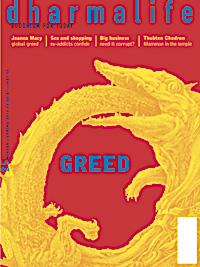The Zen of Creativity
Cultivating Your Artistic Life
John Daido Loori
Ballantine Books 2004, $25.95 /£19.95 h/b
The art form of which Zen teacher John Daido Loori has the most experience is photography. He has published several books of his own photographs, and worked as a teacher of photography long before he took up Buddhist practice. His mentor was Minor White, who was recognised as one of the great photographers of the last century, though his work is now less well known. White aimed to embody his own spiritual values and inspiration in his photographs, producing haunting and mysterious images. His workshops blended photographic technique and spiritual retreat, with a twist of the encounter groups and performance art that were widespread in 1960s and '70s counter-culture.
In the first chapter of The Zen of Creativity, Loori describes his own first experience on one of White's workshops: a few hours after being woken by drums at 4am to participate in dance exercises in a pitch-dark field, he was packing his bags to leave. Other participants talked him into staying, and the experience of the workshop turned out to be an important milestone on Loori's path to Zen practice. Like the cartoonish figure in the modern rendition of one of the Zen Ox-herding pictures reproduced amid his description of the workshop, Loori realised that he had caught sight of something worth pursuing.
This book is a kind of summation of what he learnt along the way, presented in anecdotal, autobiographical form. Part One is mainly about Loori's own path in Buddhism and the arts. Part Two is practical, introducing creative and meditational exercises useful for approaching creativity - these vary from instruction in mindfulness meditation to practical suggestions for establishing and working in a creative-feedback group with friends. Part Three explores the main elements of Zen aesthetics and the traditional arts of Zen culture - the tea ceremony, calligraphy and haiku. Part Four is a coda - whenever Loori describes taking photo-graphs, he ends by saying that he bows to his subjects before leaving, and this section is a kind of bow to the earlier chapters, and to the reader, expanding the range of its themes and touching on the idea of the arts as a 'transmission outside of the scriptures'.
There are reprinted images and pithy quotations from various artists and writers throughout. For instance, from Elizabeth Bishop: 'What one seems to want in art, in experiencing it, is the same thing that is necessary for its creation, a self-forgetful, perfectly useless concentration.' Sometimes these quotations relate to the text, but usually they do not. This gives the book a kind of scrapbook or daybook quality; you can pick it up and, opening it almost anywhere, find an inspiring or suggestive quote or an appealing picture.
Although there is much here that is useful and practical, I found the most appealing aspect of the book was its autobiographical nature. Loori writes well, in familiar American English, about his own life and practice, and his encounters with his teachers and mentors. What he has to say about the arts is interesting and useful, but there are so many books on this subject that treat it more deeply. There's not really much that readers familiar with meditation or artistic practice will not have already read or experienced for themselves. But there is a remarkable spirit in the writing, Loori is an appealing companion and instructor. His narrative is relaxed and humble, and the directness and apparent candour with which he describes his experience is itself an inspiring undertone. For that quality of his voice alone, The Zen of Creativity is well worth reading.
Manjusura is a poetry reviewer for The Times Literary Supplement



